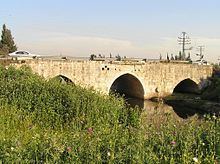Official name Jisr Jindas Opened 1273 Width 10 m | Design Arch Total length 30 m Location Lod | |
 | ||
Similar El‑Umari Mosque, Arapsu Bridge, Bridge near Limyra, Church of Saint George - L, Karamagara Bridge | ||
Jisr Jindas, also known as Baybars Bridge, was built in 1273 C.E. It crosses a small wadi, now known as the Ayalon River, on the old road between Lod and Ramla. The bridge is named after the village of Jindas, situated to the east of the bridge, which may be the casal of Gendas mentioned in a Latin charter dated 1129 CE.
Contents
It is the most famous of the several bridges erected by Sultan Baybars in Palestine (including the Yibna Bridge and the Isdud Bridge).
History
The present structure dates to 1273, but is believed to be constructed on Roman foundations. It was first studied in modern times by Charles Simon Clermont-Ganneau, who noted that an Arabic chronicle had referred to the construction by Beibars in 672 AH of two bridges build of a significant nature "in the neighbourhood of Ramleh". The second of these two bridges is thought to be the Mamluk Bridge, Yibna.
Clermont-Garneau concluded that the bridge was built using masonry reclaimed from the Church of Saint George, which had been destroyed in the Crusader-Ayyubid War.
On the west and east faces of the bridge are nearly two identical inscriptions, flanked by two lions (or leopards). The inscription on the east reads as follows:
"Bismallah..., and blessings on their lord Muhammad, his family and his companions. The building of this blessed bridge was ordered by their master, the great Sultan al-Malik al-Zahir Rukn al-Din Baybars, ibn Abd Allah, in time of his son their Lord Sultan al-Malik al-Said Nasir al-Din Baraka Khan, may Allah glorify their victories and grant them His grace. And that, under the direction of the humble servant aspiring to the mercy of Allah. Ala al-Din Ali al-Suwwaq, may Allah grant grace to him and his parents, in the month of Ramadan, the year 671 H. [March–April 1273 C.E.]
Ala al-Din Ali al-Suwwaq was the same official charged with overseeing the construction of the Great Mosque of Lydda three years earlier.
In 1882 the Palestine Exploration Fund's Survey of Western Palestine noted that Jisr Jindas had a representation of two lions and an Arabic text. The further noted that it appeared to be "Saracenic work".
Description
The bridge is over 30 metres (98 ft) long and 10 metres (33 ft) wide, and runs north-south. It consists of three arches and two central piers, with the central arch wider than the two other arches.
Baybars lions
According to Moshe Sharon, the lions on Jisr Jinda are similar to the ones on the Lions' Gate in Jerusalem, and Qasr al-Basha in Gaza. All represent the same Sultan: Baybars. The Gaza lions were created with interlocking lines, however, the shape is similar. Sharon estimates that they all date to approximately 1273 C.E.
